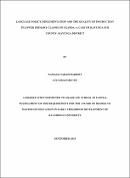| dc.description.abstract | Understanding the concept and understanding the language in which the concepts are delivered arc
usually critical areas of concern in delivery of quality instructions. Quality learning can only be
guaranteed if the learners are taught in the language they understand. Children who are taught in a
language they do not understand may not grasp the concepts not because the concepts are difficult
to understand, but rather because they do not understand the medium of the instruction. In Uganda,
while, the 1992 Government White Paper on Education and the language policy specifies the use
of area language as a medium of instruction up to primary three to be the local area language,
teachers continue to instruct the children in English that is hardly understood by learners. This
study attempted to establish how Language policy was being implemented to improve quality of
instruction in lower primary classes. The objectives included assessing the teachers' attitude
toward language policy implementation; the extent to which teachers were implementing language
policy in lower primary classes and the strategic measures that could be employed to improve the
implementation of language policy for quality instruction. Area of study was limited to 28 schools
out of the 30 primary schools in Kayunga sub-county, among lower primary teachers, head
teachers, Coordinating Centre Tutor, District Education Officer and pupils. Data was analysed
using descriptive analysis and transcribed using qualitative content analysis. The study established
that teachers had negative attitude towards language policy implementation which influences the
quality of instruction in lower primary classes at 86.35% while 13.65% had positive attitude. The
use of local language during instruction was found to be minimal at 14.78%, while 85.22% used
English in all lessons, the findings of the study would help to make informed decisions on why
teachers continue to pay less attention in using local language during instruction. Sensitisation of
teachers was recommended as a tool for embracing implementation of the language policy to
improve the quality of instruction. | en_US |

